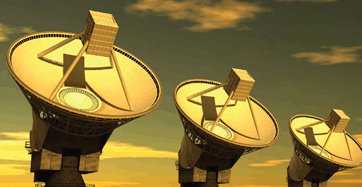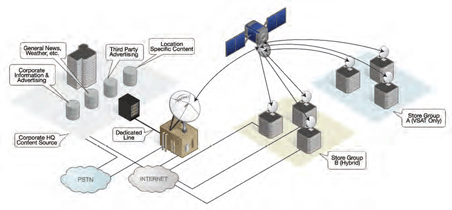Multicast for Digital Signage Networks

Advantages of Satellite for Digital Media and Content delivery A key component to any digital media solution is having a scaleable and dependable network in order to reach the intended audience. Many businesses begin by using common-carrier IP
connections, including DSL or cable. But these technologies are based on unicast (one-to-one communication). As the digital-media network expands to hundreds or thousands of locations, unicast is often not an economical or scaleable solution. Satellite, on the other hand, is designed to support broadband and multicast (one-to-many communication) more efficiently than traditional IP unicast networks. It provides the ability to cost-effectively and rapidly deliver large volumes of content to multiple remote locations.
Although satellite has proven to be a reliable and efficient content distribution solution for digital media, it is often overlooked due to the misconceptions that have developed about satellite technology. Over the years, satellite networks have undergone a number of transformations. Currently, satellite has adopted next-generation protocols to support new applications, including virtually any IP application. The technology offers faster speeds, advanced functionality, and support for new applications, including digital signage.
Satellite communications provides one of the most efficient means of transmitting and receiving data across a large geographic area. A single satellite transmission can cover all of North and South America, for instance. This ability to multicast information from a single point is a fast and efficient way to deliver one or multiple messages to large groups across a widely dispersed area. Because only one copy of a packet needs to traverse a link, it’s also a more cost-effective method to deliver information to a large number of users. Satellite also ensures there is only one network to manage; other options with comparable footprints likely require multiple terrestrial connectivity vendors. Satellite is also unique in its ability to quickly establish a broadband network virtually anywhere and isn’t susceptible to damage of physical lines or cables like terrestrial options are.

many remote locations. Satellite provides reliable content distribution via its inherent multicast capabilities (the process of sending data across a network to several recipients simultaneously) and enables clients to verify and track how often content is viewed.
MORE COST EFFECTIVE THAN WIRELINE ALTERNATIVES
The multicast capabilities of satellite enable content to be delivered more cost-effectively and efficiently than alternative unicast delivery methods via DSL or cable. For example, it would take approximately 9 minutes to send a 100 MB file from a corporate headquarters to 1000 sites via a 1.5 Mbps (megabits per second) satellite connection. It would take approximately 5 hours to send this same file to all 1000 sites if each site was connected to the corporate network via a 1.5 Mbps DSL or cable connection.
Multicast via satellite also can be significantly less expensive than unicast delivery via wireline connections because less bandwidth is required to deliver multicast content from one source to multiple sites.
A daily selection of the top stories for AV integrators, resellers and consultants. Sign up below.
EASY INTEGRATION AND MANAGEMENT
Satellite communications systems are easier than ever before to integrate into existing IT infrastructures. For example, Cisco Systems’ VSAT network module is essentially a satellite modem on a card that can easily be slipped into the routers already at a location. And because the satellite software is integrated into the router’s operating system, any Cisco-certified network engineer can manage the satellite link — just like any other IP connection.
SUPPORTS MULTIPLE APPLICATIONS AND INCREASES ROI
Another benefit of satellite is its ability to serve as a hot standby backup network that pays for itself in a digital media solution. Organizations can use the satellite network during “normal mode” for broadcast applications. In the event of a disaster, these applications are temporarily suspended, while more critical voice and data traffic is routed over the satellite until wireline communications are restored.
CASE STUDY
For a large “Big Box” retailer with over 1500 locations nationwide, a satellite network served not only as a means of business continuity, but paid for itself during normal operations with a digital media application.

a business continuity solution to support critical transactions for a large multilane point-of-sale system, as well as back-office and applications.
Solution: To meet both requirements, the company deployed a customized VSAT satellite network combining both digital media and business continuity applications on a single platform. During normal operations, the stores’ T-1 lines serve as the primary link for all point-of-sale and back-office traffic while the satellite provides multicast delivery of content for in-store digital signage displays. In the event of a terrestrial link failure, the digital signage application reverts to cached content, while all critical point-of-sale transactions and back-office applications are automatically re-routed over the always-on satellite connection.
Success: By intelligently combining both applications onto a single network, the retail chain successfully implemented their digital media application and saw an increase in per customer sales of 5-7 percent per store. Simultaneously, they were able to meet the objective of implementing a continuity of operations system. The combined solution actually lowered the clients overall capital expenditure and operation expense costs compared to two stand-alone systems for digital signage and business continuity.
Satellite offers unique broadband capabilities for digital media and is an ideal transport mechanism for content sent from a corporate headquarters to many locations.
Jon Douglas (jon.Douglas@spacenet.com) is director of marketing for Spacenet. Prior to joining Spacenet, Douglas directed all global strategic marketing initiatives for Aruba Networks’ public sector division.
